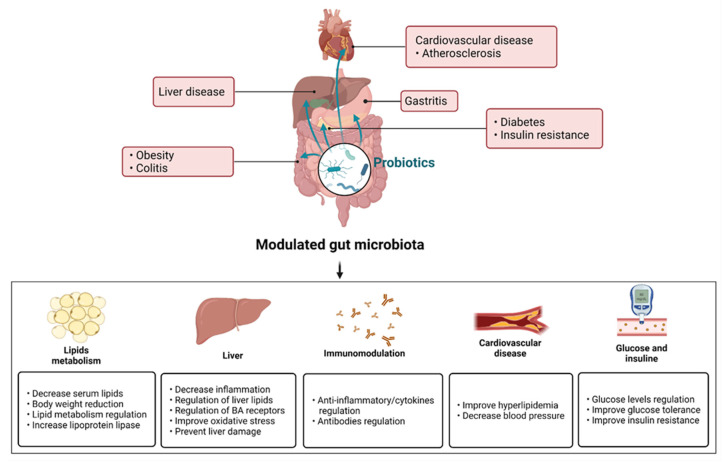Figure 1.
A balanced gut microbiota implies an increase in the abundance and diversity of beneficial species and a decrease in pathogenic bacteria. This leads to reduction in intestinal hyperpermeability and the prevention of infections. Prebiotics, probiotics, and synbiotics are related to hepatic, cardiovascular, gastrointestinal, and metabolic disorders; for example, liver injury, such as NAFLD and NASH; gastrointestinal diseases, such as gastritis and colitis; diseases related to lipid metabolism, including hyperlipidemia, obesity, and atherosclerosis; and diabetes. The administration of prebiotics, probiotics, and synbiotics confers various benefits. In lipid metabolism, serum lipid regulation has been reported, specifically of TC, VLDL-C, LDL-C, TG, and TBA; this regulation has been related to the low expression of SREBP-1c and CYP7A1, among other effects, in addition to the decrease in body weight and the positive regulation of PPAR-α, PPAR-γ, and lipoprotein lipase. Liver injury has been improved to reduce AST, ALT, AP, oxidative stress, and hepatic lipid accumulation. An immunomodulatory effect was observed, mainly anti-inflammatory, due to the decrease in proinflammatory cytokines (TNF-alpha, IL-6, IL-1β, and C-reactive protein) and the increased expression of anti-inflammatory cytokine IL-10 and the antibody IgA. Cardiovascular diseases have been improved for blood pressure regulation (systolic and diastolic) and serum levels decreased in hyperlipidemia. Finally, in diabetes, significant reductions in glucose serum levels, fasting serum glucose, glucose tolerance, and insulin resistance have been observed.

